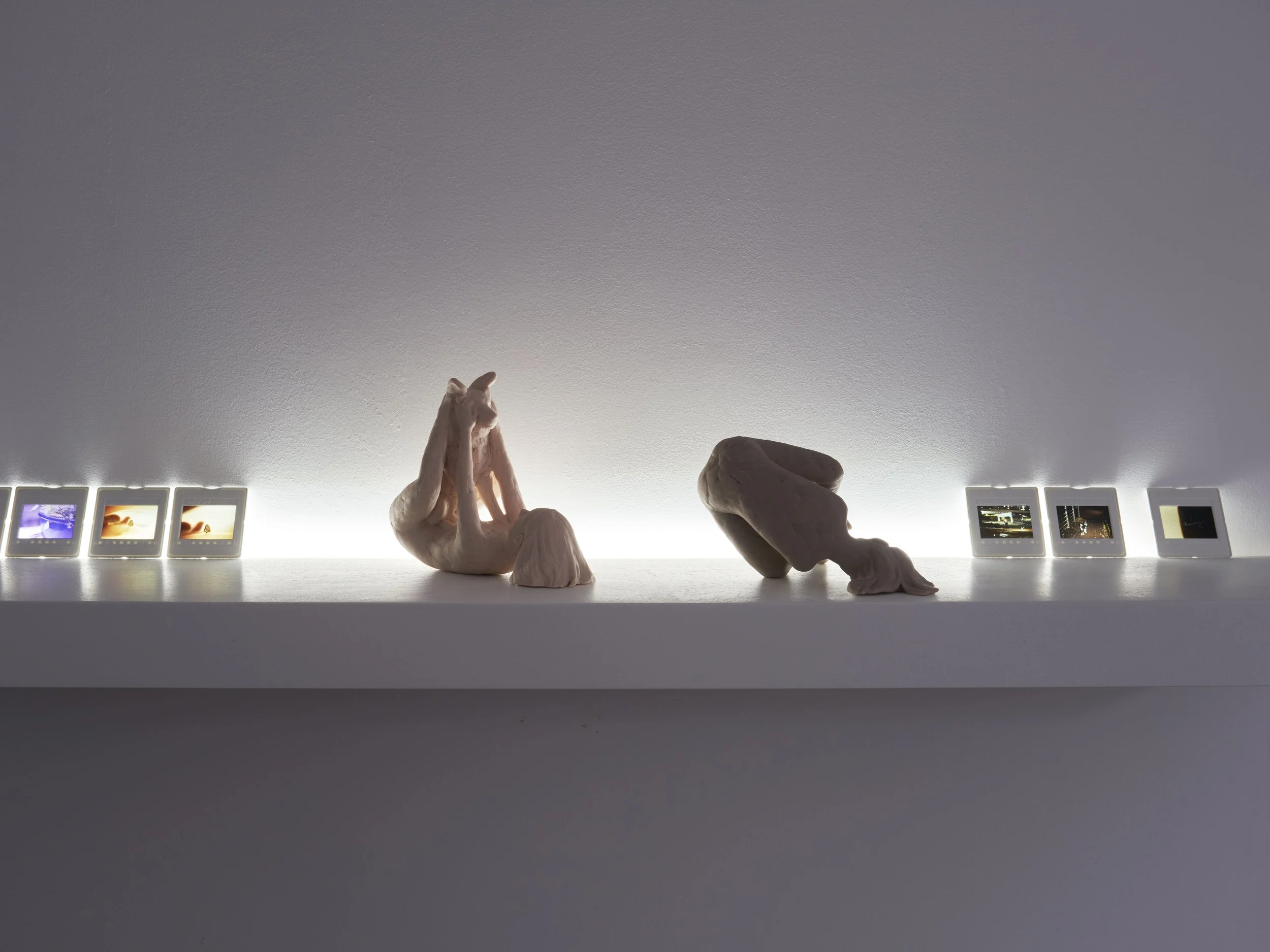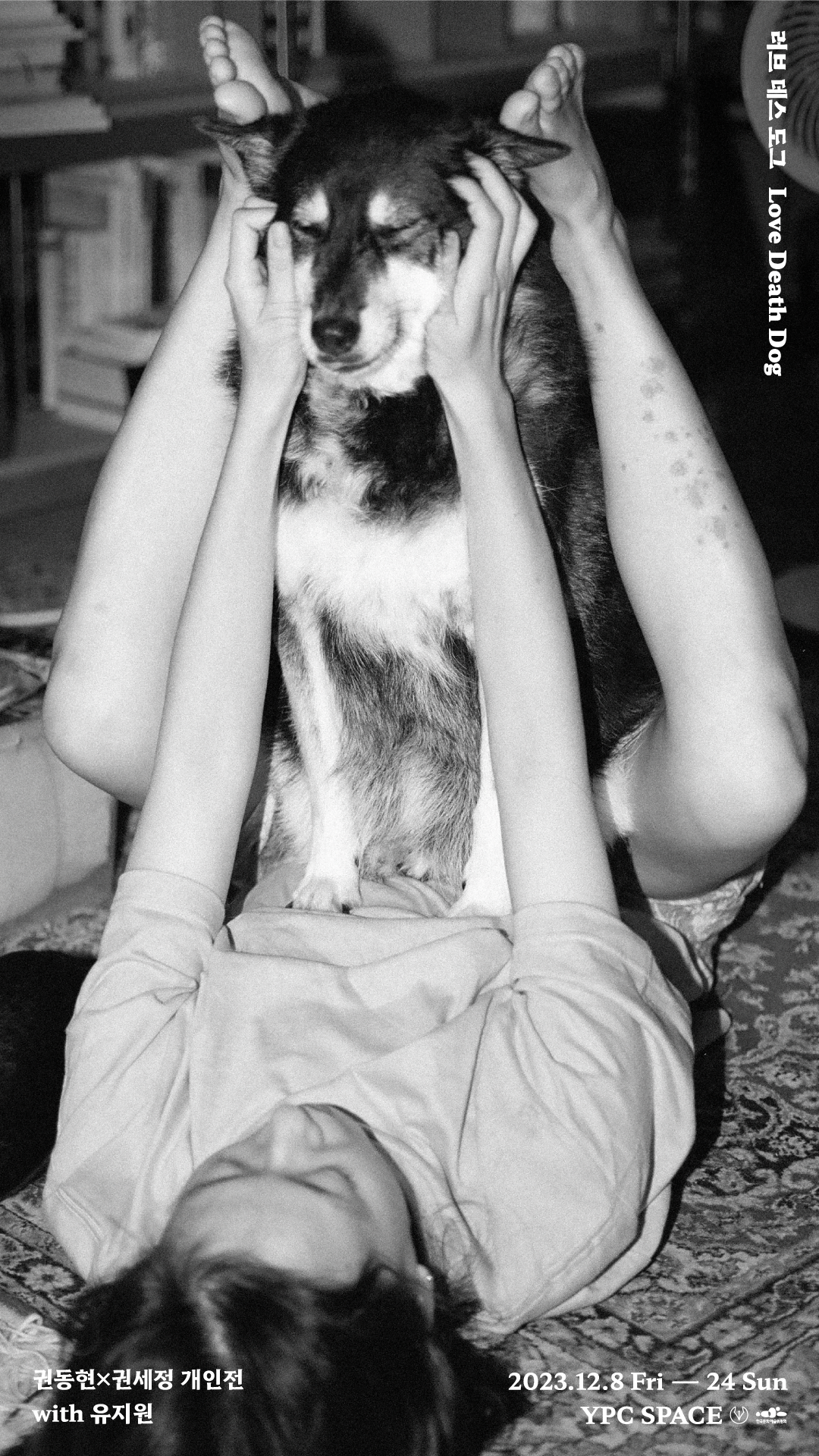Dong Hyun Gwon × Sea Jung Kwon: Love Death Dog
권동현×권세정: 러브 데스 도그
8-24 December, 2023
YPC SPACE, Seoul
권동현×권세정은 2020년 결성 이래로 도시와 비인간, 인간이 교차하는 지점에서 발생하는 물질과 감정을 관찰해왔다. 특히, 가족과 수년을 함께 지낸 개의 죽음을 계기로 인간과 동물이 공존하는 다양한 양상을 살피며, 그 모습의 연원을 추적하는 리서치 기반 장기 프로젝트 ‘러브 데스 도그 시티’(2022~)를 진행 중이다. 권동현×권세정의 첫 개인전 «러브 데스 도그»는 이 프로젝트의 일환으로, 100여 년 전 개와 인간의 이야기를 따라가는 신작 영상과 사변적 조형 실천을 함께 선보인다.
‹러브 데스 도그 & 에필로그›는 20세기 초 일본 제국이 식민지 조선에 실시한 인류학적 조사의 결과물인 유리 건판 사진을 살피며 시작된다. 식민 지배를 정당화하기 위해 조선인의 신체를 측정하고, 지역의 풍습과 풍경을 기록한 빛바랜 흔적에 마치 늘 거기 있었다는 듯 개가 등장한다. “식민지 조선에 관한 인류학 조사에서 이 개는 어쩌다 사진에 담기게 되었을까?” 이 질문은 당시 조선인이 처한 통제와 지배 논리가 우리와 함께 살아간 동물에게까지 적용된 역사를 추적하며, 인간과 비인간이 “동등하게 낮은” 위치에 공존했던 상황의 윤곽을 밝힌다. 개를 인간 소유로 한정하고, 통제가 어려운 개체를 처분하며, 신체를 전쟁 물자로 강탈하는 조치가 순차적으로 진행되면서 인간과 동물은 함께 근대 사회로 진입한다.
동일한 프로젝트의 이전 버전에 비해, 사료를 기반으로 한 역사적 관점을 적극적으로 취한 권동현×권세정은 거시적인 관점에서 종을 초월한 연대의 근거를 도출하는 동시에 시선의 윤리, 즉 무언가를 바라보고, 포착하며, 기록하는 데 개입되는 위계의 문제를 다룬다. 이는 곧 인간-비인간의 관계를 누구의 목소리와 관점에서 전하는가의 질문으로 이어진다. 이에 대한 잠정적인 답변으로써, 하나는 앙상한 반려견의 마지막 날들을 마치 어루만지듯 긴밀하게 촬영한 푸티지일 것이고, 다른 하나는 인간과 동물이 그리 뚜렷하게 구별되지 않던 먼 과거의 어떤 존재의 관점에서 사변을 펼치는 에필로그일 것이다. 영상의 전반부에서 역사적 사실과 기록물을 꿰어 작은 역사를 그려본 것이 무색하게 후반부는 누구도 대신 말할 수 없는 사적인 감각과 미지의 존재의 시점에서 사변한 과감한 비약을 제시하여 수렴되려는 목소리를 흩어놓는다. 바로 지금의 순간과 인류가 겨우 기억할까 말까 한 아득히 먼 시점이 뒤섞이고, 인간과 개와 늑대와 온갖 작은 생명의 걸음이 교차한다.
그리고 또 다른 제안은 전시장 곳곳에 배치된 인공 신체 파편이다. 듬성듬성 털이 난 팔뚝과 얼굴은 인간도 동물도 아니며, 과거나 미래 그 어느 구체적인 지점에 귀속되지 않는 중간적 존재를 상징한다. 더 넓은 범주의 ‘우리’의 이야기를 읊어줄 누군가를 기다린 끝에 등장한 혹은 발굴된 존재. 그것을 알아보기 위해서 필요한 것은 치밀한 설득이 아닌 약간의 흉내 내기로 이로 인한 혼동이다. 창밖으로 연기를 뿜어내는 이 존재가 곁에서 담배를 피우는 친근한 이던가 아니면 호랑이 담배 피우던 시절부터 줄곧 저 멀리 내다보던 야생의 존재였던가. 빼꼼 열린 문 사이로 보이는 저 얼굴은 단 한 사람의 그것이었던가 아니면 누구의 것이라도 될 수 있는 가면이었던가. 그들의 목소리는 또 어땠던가. 더불어 제시된 일련의 슬라이드 필름은 그 형태는 마치 아카이브로서 가치가 있는 자료를 흉내 내지만 실은 누군가의 내밀한 생활상이고, 작고 사소한 이미지에 불과하다고 치부하자면 못내 아쉬운 우리 ‘풍속’에 대한 증거물이다. 갸우뚱하는 가운데 누군가의 가족으로 살아가는 한 마리 개는 곧 이 도시를 사는 모든 개, 나아가 이들의 먼 조상, 그리고 이들과 함께했던 우리의 조상에까지 손짓한다. 그때나 지금이나 배 위에 개를 올리고, 닳도록 쓰다듬으며.
*권동현×권세정(2020년 결성, 서울 활동)은 인간-동물 혹은 비인간-동물 구도의 이분법적 사고를 벗어나 뒤엉킨 상황, 연결의 순간, 사랑의 관계로 조명하는 이야기와 이미지를 좇고 있다. 이를 통해 스스로를 재발견하고, 다종다양한 존재와 개별적인 관계를 맺는 가능성을 상상한다. 현실 속 대상을 탐구하는 다큐멘터리의 영상 방법론과 사물과 관념 사이에 놓인 조각의 방법론, 즉 상호보완적인 두 매체를 통해 발화하는 방법을 모색한다. 서울미디어시티비엔날레 사전프로그램 《테라인포밍》(2022, 서울시립미술관), 프리즈 필름 서울 2022 《I Am My Own Other》 등에 참여했으며, 제49회 서울독립영화제(2023) ‘새로운 선택’ 부문에서 다큐멘터리 ‹러브 데스 도그›(2023)를 선보였다.
A two-person collective formed in 2020, Dong Hyun Gwon × Sea Jung Kwon explore the physical and affective traces at the intersection of the city, non-human beings, and humans. Inspired by the death of a beloved companion dog, their long-term research-based project Love Death Dog City (2022- ) navigates the myriad of ways humans and non-human beings have coexisted with at once investigative and speculative approaches. Their first solo exhibition presents the latest version of their films, tracing back human and dog relationship in the 20th century colonial Joseon and a series of sculptures that take a leap of speculation.
Love Death Dog & Epilogue begins by examining dry glass photographs, which serve as an archive of anthropological investigation conducted on Joseon by the Japanese Empire in the early 20th century. Among the faded images from a series of research - measuring Joseon people’s bodies and documenting the local landscape and custom - to justify the colonial rule, dogs are with us, as if they’ve been there all along. “How did this dog end up in a photograph during an anthropological investigation by the Japanese Government-General of Korea?” This question prompts us to trace back how the logic of control that dominated the Joseon people at the time was also applied to the animals that lived among us. It ultimately leads us to where humans and non-humans were placed at “an equally low level.” As measures were taken to limit dogs to human ownership, dispose of ones that were out of human control, and rob their - humans’ and dogs’ alike - bodies as war materials, humans and animals entered modern society together.
Compared to previous versions of the same project, Dong Hyun Gwon × Sea Jung Kwon mobilizes a historical perspective based on a physical archive. This approach provides them with tools to support solidarity across species while leading them to deliberate on the ethics of perspective or the hierarchy involved in viewing, capturing, and recording a subject matter. Furthermore, the dilemma of representation: whose voice should be the one to tell the story of human-nonhuman relationships? One tentative answer can be found in the latter half of the film when the camera tightly zooms in on a frail dog on his last days as if caressing him. The other would be the epilogue that unfolds speculation from the perspective of the unknown, likely to belong to a far past when it was more difficult to tell apart human and animal. Contrary to the first half of the film which weaves together a small piece of history based on historical facts and archival materials, the latter half presents private sensibility that cannot be spoken for by the others and bold leaps of speculation, decentralizing a single storyteller’s voice. The present moment and the far past that humanity can barely remember merge as the footsteps of humans, dogs, wolves, and all kinds of small lives share the ground.
Another suggestion is the artificial body fragments placed throughout the gallery. The sparsely haired forearm and the face symbolize an intermediate being that is neither human nor animal, and does not belong to any specific point in the past or future. This is an attempt to imagine a long-awaited being could finally tell the broader story about “us.” All we need to recognize them is not persuasion but some mimicking that would trigger confusion. Is this being spewing smoke out the window a smoker friend of mine, or is it an ancient smoking tiger from Korean fables? Does that face peeking through the open door belong to just one person, or is it a mask that could have belonged to anyone? What was their voice like? In addition, a series of slide films tricks you into thinking they are valuable archive material, but in fact, they are traces of someone's intimate life, or witnesses to how people live and love. Through the crevice of confusion lies a beloved family dog and the dogs of the city, and their ancestors, and our ancestors who belonged to them. Then and now, one puts their animal on the belly and strokes it again, and again.
*Dong Hyun Gwon × Sea Jung Kwon (formed in 2020, based in Seoul) attempts to escape the dichotomy of human and animal by pursuing narratives and images that explore this relationship in terms of entanglement, connection, and love. Their practice is a way to rediscover themselves by imagining singular relationship(s) with various beings. They work with documentary that navigates reality as well as sculptural practice that lies between objects and ideas, using both artistic mediums to develop their language. They have participated in the 12th Seoul Mediacity pre-Biennale Terrainfomring (2022, Seoul Museum of Art), Frieze Film Seoul 2022 I AM MY OWN OTHER, and recently premiered a documentary Love Death Dog (2023) at the 49th Seoul Independent Film Festiva.




